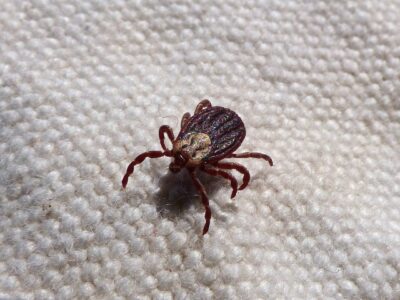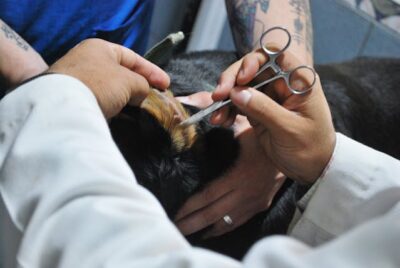Overview
Introduction to Ear Mites in Dogs

Eradicating ear mites in dogs is crucial for their ear health and overall well-being. These tiny parasites can wreak havoc in a dog’s ears, leading to discomfort, irritation, and even ear infections if left untreated.
Understanding ear mites, their life cycle, and how they infest a dog’s ear canal is essential for effective treatment and prevention.
This guide will provide you with comprehensive information on identifying, treating, and preventing ear mites infestation in your furry friend’s ears.
What Are Ear Mites?
Ear mites are tiny parasites that can infest a dog’s ears, leading to discomfort and irritation. They feed on ear wax and oils in the dog’s ear canal, causing inflammation and sometimes an ear infection.
Ear mite infestation, also known as dog ear mites, is common in dogs and can be identified by symptoms like itching, head shaking, and dark discharge from the ears.
Proper diagnosis and treatment are essential to relieve the dog’s discomfort and prevent the spread of ear mites.
How Ear Mites Affect Dogs
Ear mite infestations can lead to various issues in dogs’ ears, including ear irritation and inflammation. The presence of ear mites can cause dogs to scratch their ears excessively, leading to further irritation and discomfort.
In some cases, ear mite infestations can also result in secondary ear infections, which may require veterinary treatment. It’s important to address ear mite infestations promptly to prevent further complications and ensure the well-being of your dog’s ear canals.

Understanding Ear Mites
Life Cycle of Ear Mites
Understanding the life cycle of ear mites is crucial for effective treatment. Ear mites, barely visible to the naked eye, tend to infest the ear canal of dogs, including puppies, feeding on ear wax and oils.
They start as eggs, hatch into larvae, develop into nymphs, and eventually become adult mites. Adult mites feed on the surface of the ear canal, causing irritation and discomfort to puppies and adult dogs.
Dog’s Symptoms of Ear Mite Infestation
Understanding the symptoms of ear mite infestation is crucial for early detection and treatment. Dogs with ear mites often exhibit clinical signs such as excessive scratching of the ears, head shaking, and ear irritation.
The presence of ear mites can lead to a build-up of ear wax and may cause secondary infections like fungal infections.
Additionally, dogs with ear mites may show signs of discomfort by constantly scratching their ears, leading to hair loss, skin issues, and skin irritation. A strong odor may also be present in the ears or on the surrounding skin.
How Ear Mites Are Diagnosed
Ear mites are diagnosed through a physical examination of the ear canals, looking for signs of ear infections, such as redness, swelling, or discharge. Veterinarians also check for the presence of skin oils and other signs of ear conditions.
A common indicator of ear mites is the presence of dark, coffee grounds-like debris in the ears, along with other symptoms like frequent head shaking. A thorough examination, additional tests, or microscopic evaluation of ear wax may be conducted for a definitive diagnosis.

Causes of Ear Mites in Dogs
Transmission from Other Animals
Ear mites in dogs can be caused by direct contact with infected animals, especially other dogs. These tiny parasites can easily spread from one dog to another, leading to ear issues such as excessive ear wax and irritation.
To prevent ear mite infestations, it’s important to avoid contact with animals known to have ear mites and to regularly clean your dog’s ears.
Environment and Hygiene Factors
Ear mites in dogs can also be caused by environmental factors and poor hygiene. Dogs living in crowded or unsanitary conditions are more prone to ear mites, which can lead to ear infections.
To prevent mites, maintain good hygiene for your dog and their living environment, regularly clean their bedding, and keep their ears clean and dry.
Underlying Health Conditions
Ear mites in dogs can be associated with underlying health conditions such as allergies, which can weaken the immune system and make dogs more susceptible to infestations.
Additionally, dogs with compromised immune systems due to diseases like diabetes or cancer may also be at higher risk. Regular veterinary check-ups and preventive measures against other parasites can help reduce the risk of ear mites in dogs.

Treatment Options for Ear Mites
Veterinary Examination and Diagnosis
For the treatment of ear mites, a veterinary examination and diagnosis are crucial. Veterinarians will create a treatment plan tailored to the specific needs of the pet.
Mites tend to thrive on dog ear wax, leading to infections, so pet owners need to follow the veterinarian’s instructions carefully for effective treatment.
Medications for Ear Mite Treatment
When treating ear mites in dogs, veterinarians often prescribe topical medications to apply directly to the affected ear. These topical treatments can include antiparasitic and antifungal medications to target the mites and any associated infections.
In some cases, oral medications may also be prescribed to provide comprehensive treatment. Initial treatment is usually followed by additional treatments to ensure the complete elimination of ear mites and to prevent recurrence.
Home Remedies and Preventive Measures
While home remedies for ear mites in dogs can offer temporary relief, they are not a substitute for veterinary care. Preventive measures such as regular ear cleaning and maintaining good hygiene can help reduce the risk of ear mites.
If your dog has ear mites, consult with a veterinarian for proper diagnosis and treatment, as additional treatment may be necessary to fully eliminate the mites and prevent recurrence.

Cleaning Your Dog’s Ears
Proper Ear Cleaning Techniques
Proper ear cleaning is essential to prevent ear infections and remove debris that can attract ear mites in dogs. To clean your dog’s ears, use a veterinary-approved ear cleaning solution and gently wipe the outer ear canal with a cotton ball or pad.
Avoid inserting anything into the ear canal to prevent injury. Regular ear cleaning can help maintain ear health and prevent ear mites.
Products for Ear Cleaning
When cleaning your dog’s ears, it’s essential to use products specifically designed for ear cleaning in dogs.
Avoid using harsh chemicals or home remedies that can irritate the ear canal. Look for veterinary-approved ear cleaning solutions that are gentle and safe for regular use.
Frequency of Ear Cleaning
The frequency of ear cleaning for dogs depends on their breed, ear shape, and susceptibility to ear issues. In general, cleaning your dog’s ears once a month is sufficient for most breeds.
However, dogs prone to ear infections or with floppy ears may require more frequent cleaning, as recommended by a veterinarian.

Complications from Ear Mites
Secondary Infections
One of the complications from ear mites in dogs is the development of secondary infections, such as bacterial or yeast infections.
These infections can occur when the ear mites irritate the ear canal, leading to inflammation and an ideal environment for bacteria or yeast to thrive.
Regularly cleaning your dog’s ears and taking steps to prevent ear mites can help reduce the risk of secondary infections.
Hearing Loss
Hearing loss can be a complication of ear mites in dogs, especially if left untreated. The presence of ear mites can lead to an ear infection, which, if severe, can damage the structures of the ear and affect hearing.
It’s essential to seek veterinary care if you suspect your dog has ear mites to prevent complications like hearing loss.
Excessive Scratching and Damage to the Ear Canal
One of the complications of ear mites in dogs is excessive scratching, which can lead to damage to the ear canal. This can create an ideal environment for an ear infection to develop.
If you notice your dog excessively scratching their ears, it’s important to seek veterinary attention to address the ear mites and prevent further complications.

When to See a Veterinarian
Persistent Symptoms Despite Treatment
If your furry friend continues to exhibit symptoms of ear mites despite treatment, it’s essential to consult a veterinarian.
While some surface mites may be visible to the naked eye, others may require microscopic examination for detection.
Your veterinarian can provide a thorough evaluation and recommend appropriate treatment to alleviate your dog’s discomfort.
Severe Pain or Discomfort
If your dog is experiencing severe pain or discomfort, it’s crucial to seek veterinary care promptly. Signs of severe pain may include vocalization, pawing at the ear, or reluctance to eat or drink.
A veterinarian can assess the underlying cause of your dog’s discomfort and provide appropriate treatment.
Signs of Secondary Infections
If you notice signs of secondary infections, such as foul odor, discharge, or redness in your dog’s ears, it’s important to see a veterinarian.
These infections can occur as a complication of ear mites and require veterinary treatment. Other signs may include swelling, pain, or crusting around the ear.

Home Care and Follow-up
Monitoring for Recurrence
After initial treatment for ear mites, it’s important to monitor your dog for signs of recurrence, such as scratching or shaking of the head.
Regularly check your dog’s ears for any debris or discharge and consult your veterinarian if you notice any changes. Follow-up treatment may be necessary to ensure the ear mites are completely eradicated.
Preventive Measures for Other Pets
To prevent the spread of ear mites to other pets, regularly clean their bedding and living areas.
Additionally, ensure all pets in the household are treated for ear mites, even if they are not showing symptoms. Consult your veterinarian for advice on preventive measures and regular check-ups for all your pets.
Regular Ear Checks
Regularly check your dog’s ears for signs of ear mites, such as redness, discharge, or excessive wax buildup.
If you notice any abnormalities, consult your veterinarian for further evaluation and treatment. Keeping your dog’s ears clean and dry can help prevent ear mites and other ear issues.
Conclusion: Ear Mites in Dogs
Recap of Key Points
- Ear mites are tiny parasites that can infest a dog’s ears, leading to discomfort and irritation.
- Symptoms of ear mites in dogs include itching, head shaking, and dark discharge from the ears.
- Ear mites can lead to complications such as secondary infections and hearing loss if left untreated.
- Treatment for ear mites involves veterinary examination and diagnosis, followed by appropriate medications.
- Regular ear cleaning and hygiene are important for preventing ear mites in dogs.
Importance of Early Detection and Treatment
Early detection and treatment of ear mites in dogs are crucial for preventing complications and ensuring the well-being of your pet.
Prompt treatment can help alleviate discomfort and prevent the spread of ear mites to other pets in the household.
Tips for Preventing Ear Mites in Dogs
- Keep your dog’s living area clean and free of parasites.
- Regularly clean your dog’s ears with a veterinary-approved ear cleaning solution.
- Avoid contact with animals known to have ear mites.
- Schedule regular veterinary check-ups to monitor your dog’s ear health.
- Treat all pets in the household for ear mites, even if they are not showing symptoms.
By incorporating these helpful tips into your routine and maintaining regular check-ups for your dog’s ear health, you can effectively reduce the risk of ear mites. Stay proactive and informed about your furry friend’s well-being.
Explore our regularly updated blog for valuable insights and tips that can enhance your understanding of your dog’s needs, ensuring a fulfilling and healthy life together.
Looking for a new furry friend? Check out our puppies for sale in Florida and surrounding areas. Our puppies are thoughtfully bred from reputable breeders and are guaranteed to be healthy, friendly, and well-cared for. We are committed to providing quality puppies for sale in Florida, ready to become cherished members of your family.
Frequently Asked Questions (FAQs): Ear Mites in Dogs
- What are ear mites in dogs?
- Ear mites are tiny parasites that infest a dog’s ears, causing discomfort and irritation. They are often found in infested animals and can easily spread to other furry friends.
- How do dogs get ear mites?
- Dogs can get ear mites through direct contact with an infested animal or environment. These surface mites feed on ear wax and oils in the ear canal, leading to irritation and sometimes hair loss.
- What are the symptoms of ear mites in dogs?
- Symptoms of ear mites in dogs include itching, head shaking, dark discharge from the ears, and sometimes hair loss around the ears due to excessive scratching.
- Can my dog transmit ear mites to other pets?
- Yes, dogs with ear mites can transmit them to other pets through direct contact. It’s important to treat all pets in the household if one is infested to prevent the spread of ear mites.
- How are ear mites diagnosed in dogs?
- Ear mites in dogs are diagnosed through a physical examination of the ear canals. A veterinarian may also look for signs of ear infections and examine ear wax under a microscope for mites.
- How are ear mites treated in dogs?
- Treatment for ear mites in dogs typically involves topical medications to kill the mites and alleviate symptoms. In some cases, oral medications may be prescribed for more severe infestations.




